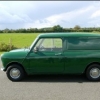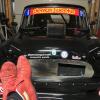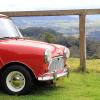I find with all new parts and set up right, the take up point is around when the pedal is half way up from the floor or maybe a bit closer to the floor.
Copy that you have checked the PIns etc, Just to ask the question here, what about the Hole in the Clutch Cover that the bigger Pin for the lower end of the Arm? I find probably 1 in 5 or so of these to be worn.
Also, at 50% travel, the very end of the Arm, with the Ball End, should be close to 90 degrees to the Plunger. It's surprising the big difference this makes. as the angles reduce from 900, the effective Plunger Travel for Arm Movement reduces as it's moving through an Arc on a small radius.
Unlikely, but just to put it out there as I've been caught on this one. There has been 2 lengths in the Slave Push Rods. The early Spring Clutches used a Shorter Push Rod.
Noted you haven't replaced the Master Cylinder. I will suggest at the very least, it would be worth overhauling it with a hone and new seals. The Clevis on these do also wear. Given that that only have around 22 mm of Travel, it doesn't take much wear here to add up to a lot at the Thrust Bearing.
I have also had soft Thrust Plates on the Diaphragms a few years back. I doubt you'd be supplied one of these now, but these wore very fast under the Bearing and they also flexed, reducing effective travel.
When setting all the adjustments, I set the Over-throw stops on the Bench, though, they can be done in car. I Put a pipe over the arm, pull it out all the way to a hard stop, then wind down the Flanged Nut to the Clutch Cover, release the Arm, then wind it on a further 1/2 a turn and lock it off there. That should never need to be touched again until the Flywheel is next removed. The Arm Stop I set by removing the Arm Spring, winding the bolt until it contacts the Arm, then wind back in until there is some clearance there, I've never bothered to measure it, but I'd say I set them around 0.010" - just enough to allow from Crank End Float and so the Bearing doesn't contact the Thrust Plate.
One last item comes to mind here. It might also be worth checking the Ball End on the Arm. I know you have replaced it, however that end of the Arm is induction hardened. I've had one and seen a couple of others where it appears that the hardening process has enbrittled that end of the Arm and just under the Ball, they have cracked.
























